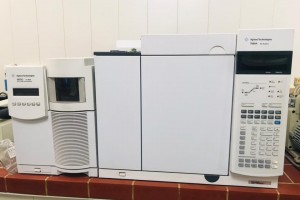
The College of Education for Pure Sciences, Department of Chemistry, University of Basra, discussed a doctoral thesis on the preparation and characterization of azo dyes and their complexes with Co(II) and Fe(III) ions and their use as corrosion inhibitors.
The thesis presented by the researcher (Hadi Thamer Obaid) included the preparation of two types of ligands, namely, azo ligands derived from 2-hydroxynaphthaldehyde, and the second, two new ligands containing in their chemical composition the azo and azomethane groups, were identified by the following techniques. (HNMR, C13NMR, FT-IR), as well as measuring the magnetic susceptibility of complexes in their solid state. As for the second axis, it included the use of some ligandines (R1H, S1H) as corrosion inhibitors for carbon steel alloy using the two methods of liberated hydrogen and complementary polarization, as it was found that the inhibition efficiency increases with the increase in the concentration of the inhibitor for each temperature separately. The axis also included calculating the theoretical results by computer chemistry programs to evaluate the efficiency of the prepared lycandins (S1H-R1H) as corrosion inhibitors for carbon steel alloy. All the results obtained from quantum chemical calculations excellently support the experimental results.
Thesis objectives:
Preparation of azo dyes, followed by the preparation of new homogeneous ring azo-azomethane ligands, and then preparing a number of complexes of azo ligands only through their interaction with cobalt (II) and iron (III) ions, purification and stabilization of some of their physical and chemical properties.
And the diagnosis of the structures of the prepared ligands and their complexes using available analytical and spectroscopic methods such as infrared spectra, nuclear magnetic resonance spectra of protons and isotopes of carbon (13) in addition to the mass spectra of these ligands and the results of electronic spectra of solutions of these complexes, and determination of the ratio (metal: ligand) for the azo ligands complexes using the prepared results. The Flame Atomic Absorption Technique and Suggestion of the Stereotype Using the Results of Magnetic Sensitivity and Molar Electric Conduction in order to identify the coordination sites available in the ligands that help in suggesting the stereotypes of the prepared canine complexes.
And the inhibitory performance test and evaluation of the inhibition efficiency of ligandine (R1H) and (S1H) prepared as corrosion inhibitors for carbon steel alloy in hydrochloric acid solution at a concentration of 1 mo, and comparison between their results. Computational chemistry programs for the purpose of linking theoretical results with experimental results of inhibition efficacy, supporting them and knowing the extent of congruence between the two methods
Conclusions
Most of the solid chelate complexes were unaffected by moisture and air, in addition to their high melting points. The results of thermal analysis showed that some ligands and their prepared complexes disintegrated at high temperatures, which confirms the stability of these compounds towards heat. The experimental results of the use of ligandine (S1H-R1H) prepared as corrosion inhibitors for carbon steel alloy showed that the inhibition efficiency that was obtained experimentally from the two techniques (polarization curves and free hydrogen) is very close. The theoretical results obtained by computational chemistry for evaluating the efficiency of ligandine (S1H-R1H) prepared as corrosion inhibitors for carbon steel alloy showed that all the results obtained from quantum chemical calculations support the experimental results.








